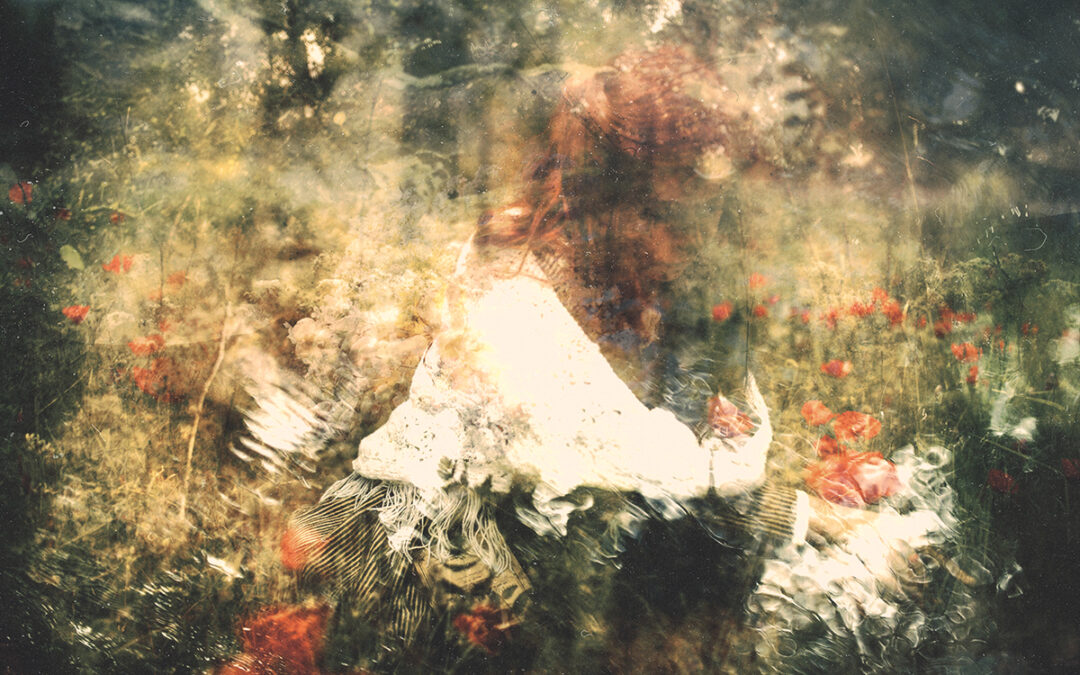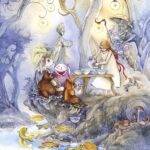Dear fellow fairytale lovers & readers,
This is part of my series “The Story Threads” where I discuss the esoteric symbology and layers of wisdom found in famous tales, lore and myth, and how it all relates to our current times and the evolution of our consciousness. Previous posts in these series include What Cinderella Knows, What The Snow Queen Knows, What Sleeping Beauty Knows, What Rapunzel Knows, Wild Marriage, The Gift of the Magi, The Dandelion Girl, What Snow White Knows, Beauty and Her Beast, Weaving Life, Bluebeard, Étaín, and many more that you can find in my folklore + myth section.
Today I wanted to tell you a beautiful tale, that has been told and retold for hundreds of years, and yet it is one that isn’t as well known or popular in the mainstream. Donkeyskin or Peau d’Âne was written in verse by Charles Perrault and first published in 1695 in France. Prior to that though, versions of this tale existed in Italy, namely The She-Bear by Giambattista Basile published in 1634. Other tales of this similar narrative include Catskin (England), All Kinds of Fur (Greece), Allerleirauh or Thousandfurs (Germany), Fair Maria Wood (Italy), Cap O’ Rushes (England), The Beautiful Princess (Lithuania), and Tattercoats (England).
One of the reasons why Perrault’s Donkeyskin was never quite popular in the mainstream, including our modern days, is that it begins with the king going mad stricken with grief and in a moment of delusion decides to marry his daughter. She flees the kingdom because obviously she isn’t too pleased with his decision, and while the ending is a happy one, we can perhaps understand why its beginning could be perceived as uncomfortable. Though I’m not sure whether it is the children or the parents that are more uncomfortable with the tale; I’d guess the latter.
There are many other versions of the story, and in the one I was told as a child, the princess flees the kingdom because she is told to marry a prince who is arrogant, rude and selfish, and whom she doesn’t love – so she escapes the kingdom in disguise. Naturally I loved this tale because I found the heroine very brave and standing strong in her values and in heart.
Unique and full of meaning, I am excited to feature Donkeyskin in my “Story Threads” series to bring into light all of its beautiful layers that unfold throughout its entirety. And while here we’ll discuss its more adult themes and esoteric symbology, I believe this tale is valuable for all age groups, including children. For those children and youth who are facing some hardship or injustice, this tale can be soothing and give them the comfort they need to know that they too can find their way and they are never alone; and for those others who haven’t experienced such hardships, this tale would serve as deeper understanding and compassion towards other children, as well as guide them on how to navigate through times of feeling lost and confused in their own lives. You can read more about the importance of fairytales for children’s wellbeing in my article The Important Benefits of Fairytales for a Child’s Wellbeing.
At the end of all of his stories, Charles Perrault always wrote a moral, and for Donkeyskin it was the discernment between duty and virtue; in the sense that, whenever we are faced with duty imposed on us by authority or work or corporation, we must do only what’s right and take a stand for our virtues, fight for our values, while staying aligned and grounded in who we truly are and what we truly want. That’s a pretty powerful lesson I think, and very relevant in our modern day. For me personally, this has always been at its essence a story about staying true to yourself and following your heart, fearlessly and with trust. As all tales, books and stories, you can have your own interpretations, and see different things during different times of your life based on your feelings and experiences. That’s the beauty of story.
Digging deeper into the history of Donkeyskin, we come across an interesting pattern: we find that perhaps the reason for the tale’s unpopularity lies in the fact that it deals with father-daughter issues, which while they had been quite popular themes ever since Greek myth and lore, because let’s face it – that was a reality for many women, and unfortunately still is throughout our world – in the recent decades the focus has shifted towards evil stepmothers and “women attacking women” giving more popularity to tales like Cinderella, The Sleeping Beauty and Snow White.
Another interesting layer to Donkeyskin is that there are similar undercurrents to Cinderella: both girls suffered from injustices, both were made to hide their beauty, yet both remained pure in heart and strong in spirit despite their circumstances – they never abandoned their true selves, and that demands courage very few people have in real life. What makes them quite different in story though is that while it was quite expected for the poor or working class to face harm, injustice and abuse, it wasn’t really brought into public awareness that even the rich and high status women would also be faced with that. Donkeyskin is a princess but she is still vulnerable to the abuse of power by the king. And unlike Cinderella, she never gets help from a magic wand, so it’s almost like this tale is more folk than fairy, and remains very much human and of the earth element, as the heroine has to exercise her own strength, wisdom and courage to escape. She eventually finds her happiness sharing a real, natural love with someone who loves her for who she is.
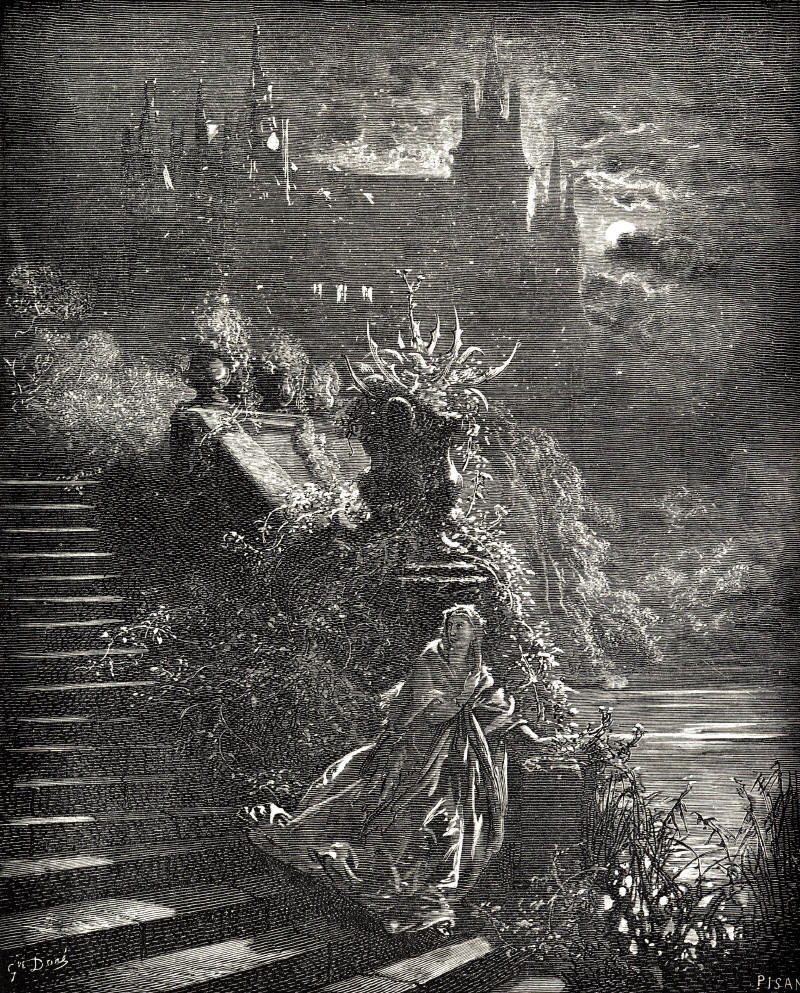

Donkeyskin Illustration by Gustave Doré
Healing is an inner path, just like spirituality and transformation are an inner pathway also and we can only walk these paths ourselves beneath the coats. While society is quick to blame all others for their problems, and many times justifiably so, there are no quick fixes to any problems, and we should always also try to shift the eyes inward. Simultaneously, as much as we are told to be our true selves, the truth is that society has never fully supported real freedom and authenticity when it challenges its own fixed narratives; so there is a need to discern, and to honour our armours of protection and set boundaries clearly. We should also know when and whom to take our armours off and who deserves our tenderness and to walk into the sanctity of our home and heart. Having a supportive environment, that truly loves us and supports us in our true selves is crucial; so it is our societies that need to create the space for that, but unfortunately, humanity still doesn’t know how to love and how to accept and how to respect.
Word goes that despite this tale not being popular in the mainstream, this was actually a favourite tale of many French princes and royals at the time, who perhaps resonated with the injustices they themselves faced within the tall walls of the rich kingdoms – injustices that they were never really able to share publicly.
To keep things into perspective, we need to remember that fairytales were initially written for adults, not children. Many French fairytale authors during the 17th century used the fairytales to raise awareness on many social issues and injustices, particularly on the mistreatment of women and children. This is why many fairytales are actually quite dark, before being retold for children – because they were meant for adults, not children, and were part of revolutionary acts. If you’ve read my article on Rapunzel you know how its author was even threatened to be imprisoned because of her tale, and because of her choice to marry a man she loved of lower class. Rapunzel was raising awareness of the mistreatment of many women, who wanted to live a free life and be able to marry the men they wanted to rather than be forced into prisons or asylums if they rebelled against it.
Donkeyskin is an important tale because it carries within itself many wisdoms and ancient teachings, just like all other tales do, but it also reminds us of the importance and sacredness of tender protection and the spiritual gift of discernment. We live in a world where boundaries are constantly crossed and even vulnerability has become commodified, which is dangerous and preys upon vulnerable people. While there are numerous who scream of paper cuts just to get more likes on social media or join the herd, the ones that do truly need help and support because they are victims, keep silent and no one notices them. This tale also speaks of the sacred art of shapeshifting, as well as the “skins” we wear, the armours that protect us, the importance of being loved for who we truly are, and how we can come back to ourselves and back to our happiness when we feel lost deep into the forests. Let’s first go through a short summary of the tale, and we’ll then move into the analysis, unveiling its magical layers of meaning, and how it applies to our modern world.
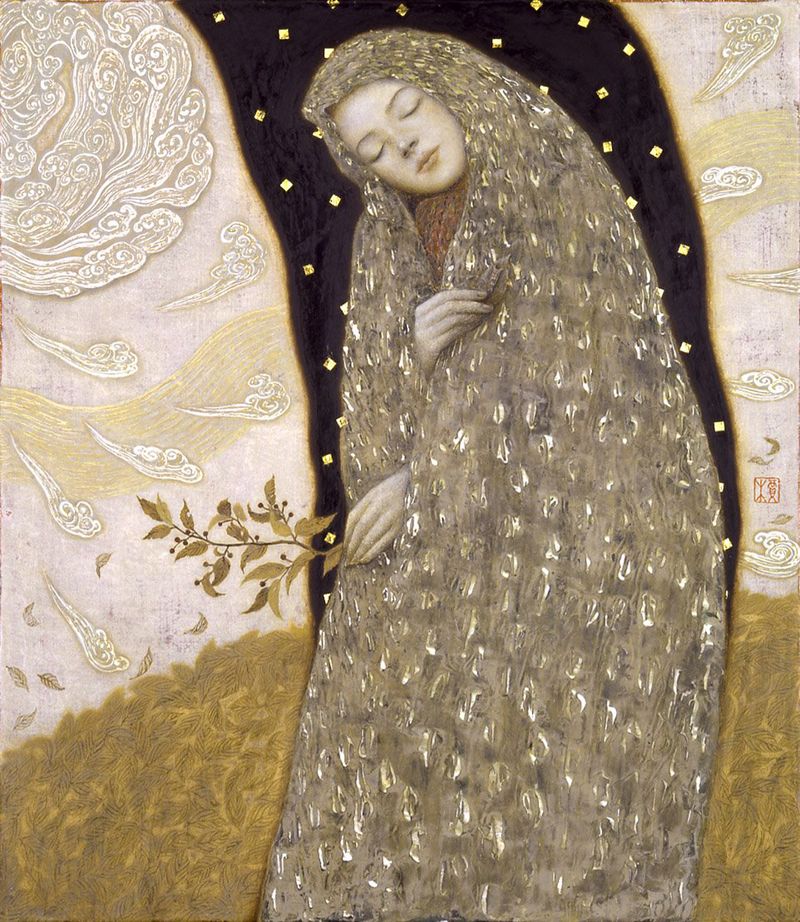
Illustration of Donkeyskin by Toshiyuki Enoki
Donkeyskin
Once upon a time in a kingdom far away a princess lived with her loving mother and father. Her father loved both his wife and daughter with all his heart, and they were all so happy together. They also had a magical donkey that would have golden coins fall from its mouth each and every day, which made them very, very rich.
The young princess was beautiful – not only externally, but in her kindness and purity of heart, which shined even brighter than all the suns and stars. When the queen fell ill, she told her husband that he should only marry a woman as beautiful and kind as her. Stricken with grief and unable to deal with her passing, the king grew madder, more troubled and more confused each day. One day when he was out in the garden, he caught the sunlight on his daughter’s face, and fell into the delusion that the queen had come to him from the afterlife telling him to marry their daughter – because only she was as beautiful and as kind as her – and this way they’ll always be together.
At the news of this, naturally the princess was completely horrified at her upcoming fate. She pleaded with her father and tried to make him see that he was troubled and that he was making a mistake, but he wouldn’t hear any of it, for he had gone mad. And so the girl ran into the forest where her fairy godmother, disguised as a beautiful white dove, showed up to soothe her. “Don’t cry my child, just listen to me and I’ll help you. You can still escape your ill fate, without necessarily displeasing him yet – you just have to ask for a task impossible to make. Go back home and tell the king that you’ll do as she wishes, but only if he makes you a beautiful dress made of all the colours of the heavens, as bright as the sun, as mysterious as the moon, and as flowing as all waters and oceans on earth.”
After the king made this dress, the fairy godmother told the princess to ask him for one last request, “Tell him that you want the hide of the magical donkey. And after he gives you this too, put your heavenly dress in this chest, put on the hide on your body, and escape into the forest. Do not fear. Just keeping going, have faith and stay courageous.”
And so the princess fled the kingdom with her donskeyskin and chest hidden underneath it, and wearing her precious ring on her finger – the one she’d worn all her life. She walked far and away until she reached a distant royal kingdom where they let her work with the donkeys and other farm animals. Everyone treated her badly because of her ugliness, but the girl kept working hard and stayed humbled, she cared for all the animals with love and kindness. As grateful as she was to have a roof and food to eat, sometimes she’d cuddle in the barn to sleep and wonder, “Is this what my life will forever be?”
On occasions, hidden in the barn, she’d open her chest and wear her dress around smiling and dancing. On one such day, the prince from the kingdom was passing by and saw a bright light coming from the little barn; so he looked through the peephole and fell in love with the princess demanding to have the barn unlocked. Upon hearing that, the princess frightened put on her donkey skin and hid amidst the dirt. So when the prince and didn’t see anything, he fell ill from love’s longing immediately.
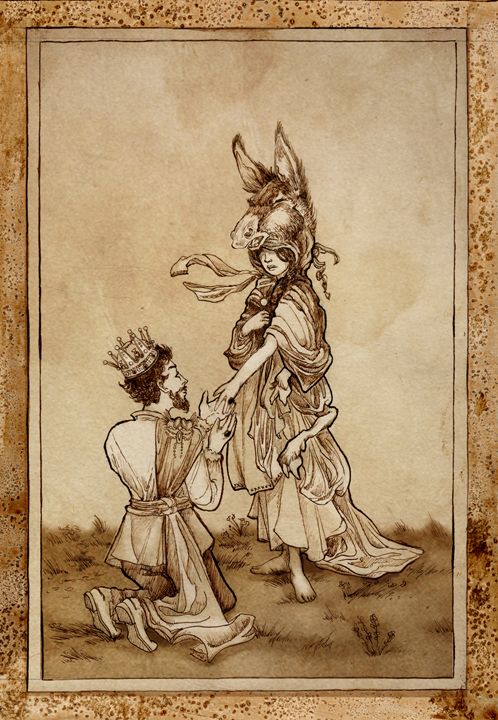
Illustration by Shelby E. Boswell
Who lives there? he demanded to know, and when he was told that it was just a poor ugly Donkeyskin girl, without hesitation he said, “Let her bake me a cake”.
Was it fate, purposeful or accidental no one knows to this day, but while baking the cake, as sweet as her heart was, her little precious ring fell into the dough. When the prince found the ring, he said that he’ll marry only the one whose finger it fit.
And so … all women came, all princesses, but no one’s hand was gentle enough. Until all those working from the farms had to try the ring also – and when all failed, the prince demanded that Donkeyskin try the ring also. All from the kingdom, except the prince of course, gasped in disbelief when the ring fit.
“Will you please do me the honour and be my bride my love. I don’t care who you are and where you come from.”
“Of course I will marry you and give you my heart, but please allow me the day, so that I can put on my true dress and show you who I truly am.”
And so, the princess finally unveiled herself in all the beauty that she already possessed in her heart, and told the prince her whole story. At their wedding, she was amazed to see her father also, who by then had healed, remarried and tearing up asked his daughter for forgiveness. Embracing in happiness and togetherness again, they all lived happily ever after.
Let’s unfold the magical layers.
The scene in which Donkeyskin throws off her cloak reveals her almost angelic self. It’s a moment at which the girl is finally able to show off her true self, and find her happiness and acceptance for who she is after much strife and fear, disguise and degradation. And what of her ugly cloak? To many people it might seem horrible, lowly and not a thing of beauty, but it serves a deeper purpose – it was the thing that helped her stay connected to herself and find her way. With its almost wild nature, it helped her reconnect to her own inner emotional and spiritual wildlands. This is the power of animal guides and totems in many Indigenous cultures. Sometimes we lose ourselves, and we feel parts of us robbed, and we need to go back to the beginnings – to the wild, to remember ourselves and reclaim our power and freedom and spirit.
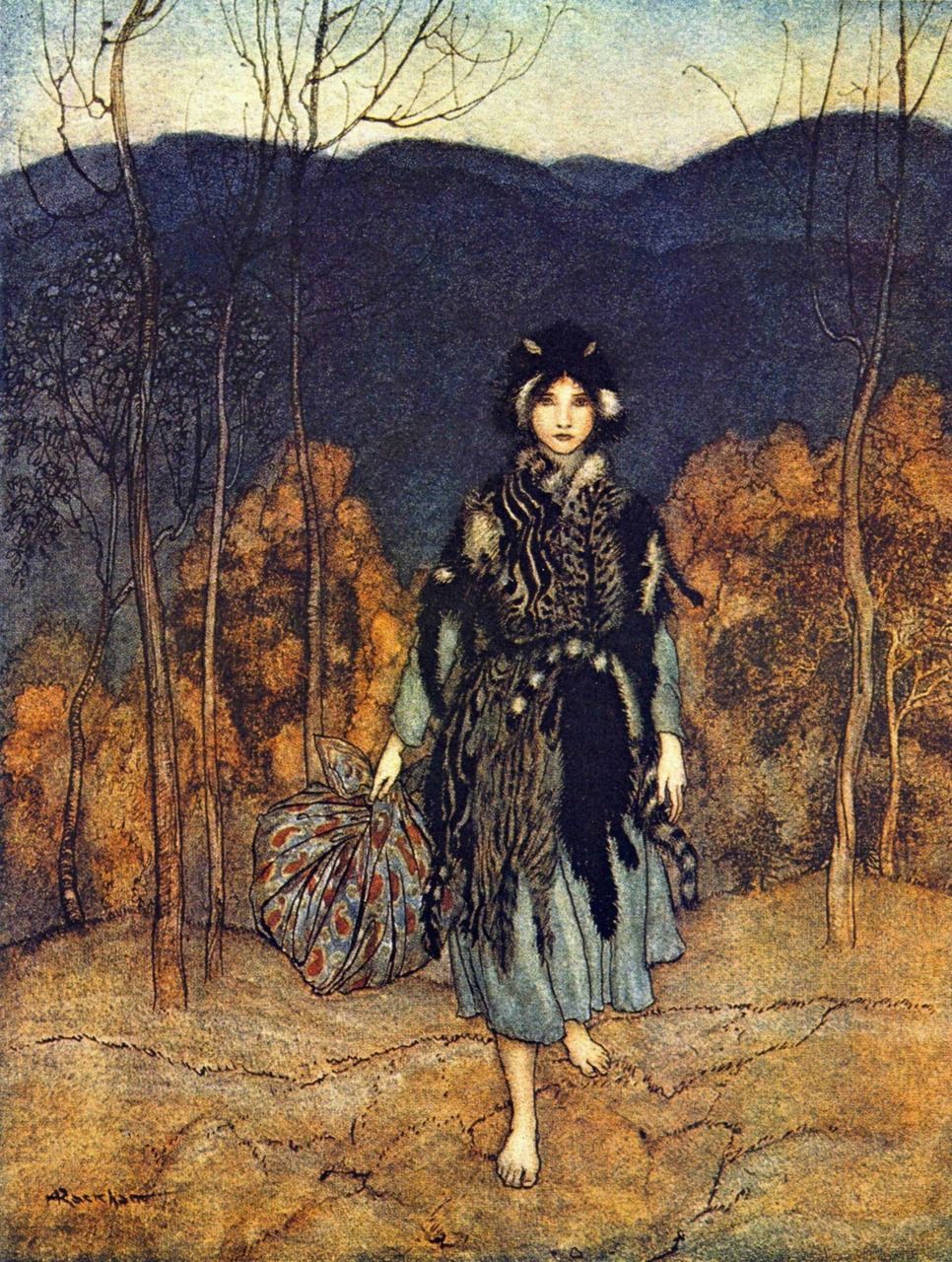
Catskin Illustrated by Arthur Rackham
It’s only another thing she assumes as skin, and this time it is for protection. We are all shapeshifters and we all wear certain identities – and yet beneath these are our true selves. You can think of it as a thicker skin that she had to wear a while to save herself and protect herself from those who wished her harm.
The truth is that our world has never really protected love, kindness and beauty – and even going back to ancient myth and lore, beauty was a thing many seek to destroy, which is why many goddesses too had to shape-shift.
Many people are threatened by beauty – they want to destroy it, steal it, own it, control it or possess it. Often times as women we suppress and hide ourselves, not because of insecurity but because this world is just sometimes not a kind and supportive world. I recently worked with a client who shared with me how she had chosen the birth of her first child to be a home birth, but the community in which she lived didn’t accept it, so she kept this private. This however caused a lot of fear for her upcoming second birth, because she kept thinking how she needs to “lie” again and hide this most precious part of her life.
She felt that she wasn’t being authentic, and this was causing her so much stress and anxiety. So I told her these ancient mystical secrets and wisdoms of the feminine – how shapeshifting is a form of discernment and setting clear boundaries, and how while she may have felt that she was living a lie – she was actually being true to herself, and didn’t abandon her own principles and morals, and despite others, she did what she believed was best for her little ones. This is courage. This is confidence.
We have to remind ourselves that not everyone deserves to know all that happens behind our closed doors; and that there are circles of trust. Our priority remains our wellbeing, our privacy, and protecting our family and little ones. If for any reason you feel that it is not best for you to share something, don’t. Don’t put yourself in harm’s way and awaken the spiritual gift of discernment.
This tale is also about the women’s rites of passage and the initiation of maturity and reclaiming her feminine power, as she learns to ride fear – and come into power, courage, trust and discernment. It is absolutely scary to leave everything that you’ve known behind and head into the unknown and uncertain.
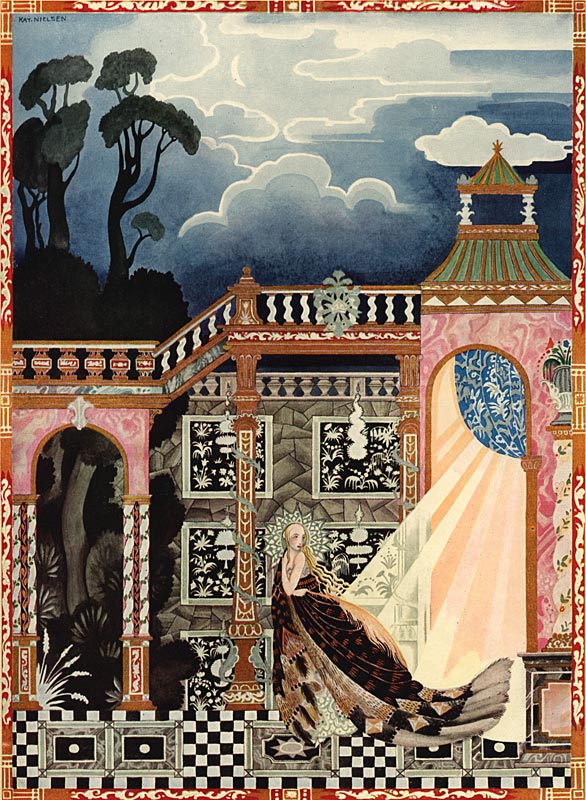
Allerleirauh (Thousandfurs) Illustration by Kay Nielson
There are two ways of facing fear: the masculine and the feminine way.
The masculine way is through facing death i.e. to fight the dragon and conquer it, and slay it. This is symbolic of the knight in shining armour, who fights the dragon i.e. his inner fears and demons, and through that he unveils his heart, his vulnerability and takes off his armour. This symbolizes coming into his emotional maturity and becoming a man.
In a way, for the masculine to mature, he needs to face his fears of death and deal with his inner issues. In many Indigenous tribes this is performed through coming of age ceremonies where they send the boys to hunt or spend time in the wild forests by themselves learning to take care of themselves and having courage, honesty and strength.
When a man does not mature properly, he gets stuck in boy psychology, incapable of stepping into his responsibility and becoming emotionally mature, which is the problem of our modern world.
The feminine way is through the way of life. In Indigenous tribes, the rite of passage for the girls involve ceremonies where they would learn to nurture, serve and connect to their intuition. They would bake cakes to feed the entire community, they would run miles to learn endurance, and they would lastly get massages to learn self-care and receiving also.
When facing fear, the feminine learns to ride fear – to make fear her ally and friend. She becomes like the queen of dragons, rather than the slayer of dragons. Just like all other emotions, we need to sit with them with kindness and compassion, tame them, and allow them to eventually approach us and tell us their messages. Why am I afraid? Have my boundaries been crossed? Our emotions carry important messages for our wellbeing, and once we learn to tune into ourselves, they become our guardian and warn us when something is not right in our life and needs to be adjusted.
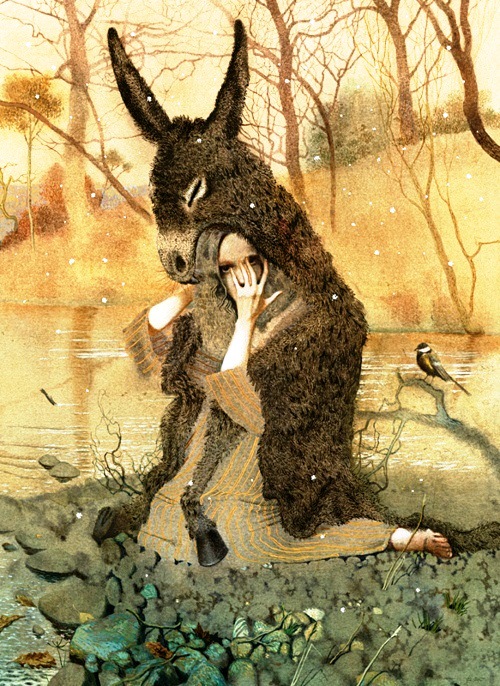
Donkeyskin by Toshiyuki Enoki
Throughout Donkeyskin’s entire journey, no matter what happened to her externally, no matter the dirt she was covered in and no matter all the doubts and fears she had, she actually didn’t lose herself. She was able to find happiness after so much fear, pain, degradation and disguise. Donkeyskin is an incredibly strong young girl, because despite her captive environment, she decides to escape even without knowing what will happen next. And after many hardships, she finally arrives at safety, appreciation and love – and at being loved for who she is.
Applying this in the context of our modern world, it raises important questions: How many times have we played small in life, dimmed our lights, downgraded our talents and skills, and hidden our beauty, just so that we can fit in among people with insecurities or stay safe in inhospitable environments?
In the old days and in mystical traditions, women and priestesses would wear makeup and veils as ways of psychic protection. Dating all the way back to 3,500 BC, ancient Egyptians used dramatic eye makeup for psychic protection, as they believed that unadorned eyes were vulnerable to harm and evil spirits.
They’d wear jewels and lead as eye-makeup, and Egyptian mothers would outline the eyes of their babies in order to protect them from the evil eye.
In a similar way, the fairy godmother advises Donkeyskin to disguise herself until it is safe for her to unveil her beauty and purity of heart. This is a powerful lesson in our world, because no matter how much we are told to shine our light, we must know when to use it and when it is wise to lay low, and we must be equipped with knowing how to take care of ourselves and trust in our judgments when we need to escape from those who wish to harm us or are toxic in our life.
Love doesn’t change nor heal all people. Our tenderness is a true gift meant to be shared only with those who are true to us, loyal to us, love us, appreciate us and respect us.
There are also cultures and spiritual beliefs where animal spirits are called upon for protection and guidance, and then invoked through dancing as the people imitate the movements of the animal.
In shamanism, as we already mentioned, animal totems and guides are meant to be a representation of the traits and skills that we are supposed to learn, acquire, or embody; we embody the qualities of our animal selves for greater spiritual development. The Shamanic teaching is that everything is alive and imbued with spirit; and we learn that all things, all people, all events, all times and all animals, no matter how tiny or big, are all connected.
The most important part of working with animal spirits is to build a relationship with them. For any relationship to work there must be three elements: silence, respect and sharing.
In his book “Animal Speaks” Ted Andrews writes that,
“Relationships teach us silence. Silence enables us to listen and to experience the relationship as it truly is. It enables us to know when to speak and act for the greatest benefit. Relationships also teach us respect for other lives, and to only take that, which is truly needed. Relationships also teach us sharing. They teach us how to live in the world with one another.”
This is the way we approach all relationships – relationships towards ourselves, and other people. In the tale, she allows herself the time and patience, to heal and transform in her way own.
The cloak allows her this silence and stillness, and the protection she needs while she feels vulnerable – so that she can also truly hear what her body and emotions need. Next, she respects how she feels and what she needs – she honours her feelings and needs. And as she opens herself to share of herself and take care of the animals in the farm, while also spending time to dressup and dance around, she shares more of her heart, opening her heart and coming more into herself. Being of service is something that gives us purpose, and the more we love, the more we grow.
We are constantly in relationships with all and everything – with life itself, with nature, with wildlife, with our furniture and with the streets upon which our feet walk. How we treat one is a reflection of how we’ll treat another.
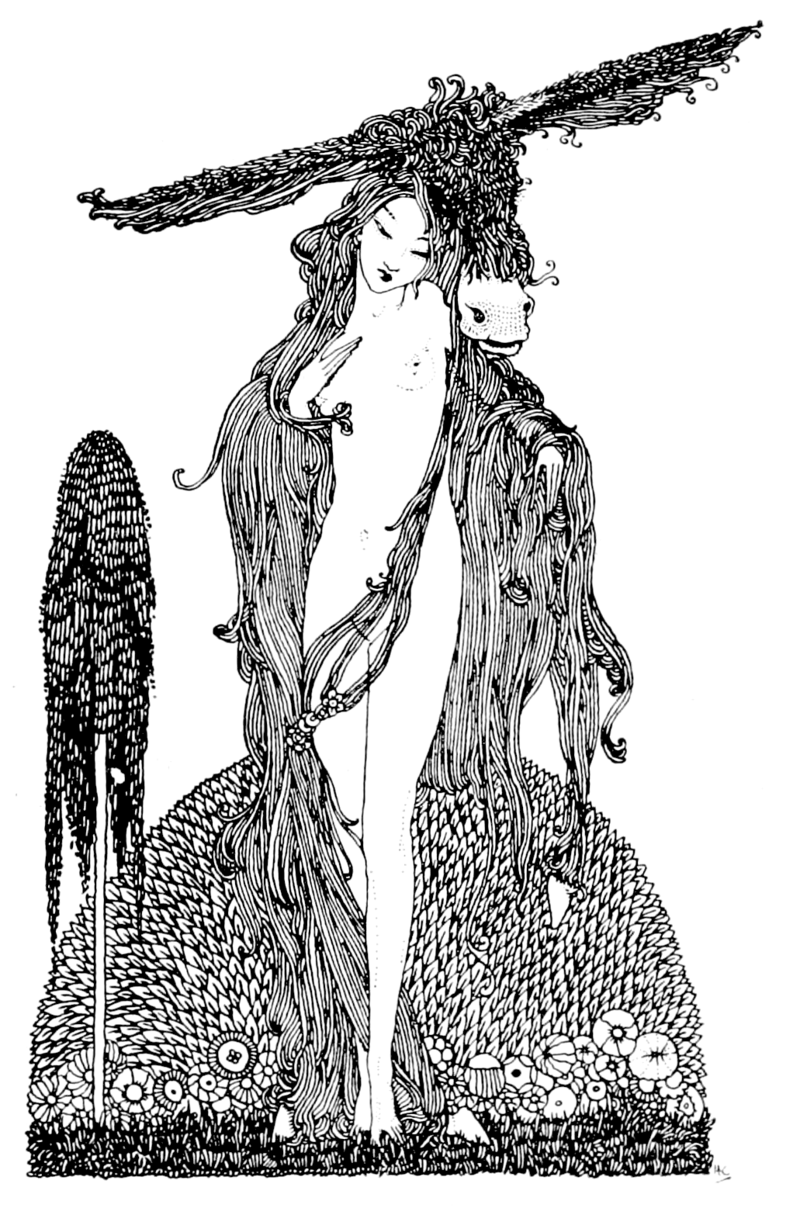
Donkeyskin by Harry Clarke
Donkeyskin knows that we need to honour and celebrate tender protection. She wears her coat because it is hers. Because it has been woven around her over many years, because she has worked diligently and ceaselessly to keep it clean and in good repair through the rough weathers and long freezing winters.
She wears her coat because of how the wind wildly swung its hem across, and the brilliance of its colour shined against the forest browns; because of how strong its grip is on her shoulders and across her back to give her stability.
She wears her coat because it is threaded through her hesitations, sensitivities, hopes, dreams and quiet tears, and joyful heart-full celebrations of her little successes along the way; because the dust, and mud, and dusk and dawn have all been placed there by her own hands and songs and prayers and trust and courage all kissed love to hold her.
She wears her coat because she can walk inside the wonder of it, and the wonder of it steps inside herself, its magic infuses her magic, its mystery gently touches her, and in that touch she reminds herself of the need to let some pages unwritten so that God too breathes, speaks, and surprises her with a miracle.
She wears her coats because in that touch of fur and skin, she remembers, she leans and she learns and she surrenders and she returns.
She wears her coat because there is power kept inside of it, there is memory of soul kept inside of it, there is wisdom kept inside of it, as ordinary as a pebble or a bean, as simple as moonlight or skin. She wears her coat because it is wide enough to carry her in all her uncertainties and sadness and burdens and fears, and still comfort her and provide her stability; because it is wide enough to stretch like wings and then wrap around to warm her like the hearth of a home, like the generosity of a stranger, like the kindness of nature.
She wears her coat because it is the shape and texture and temperature and all the complex shades of her. She wears her coat because it is hers, and do not ask her to take it off, if you are still wearing yours.
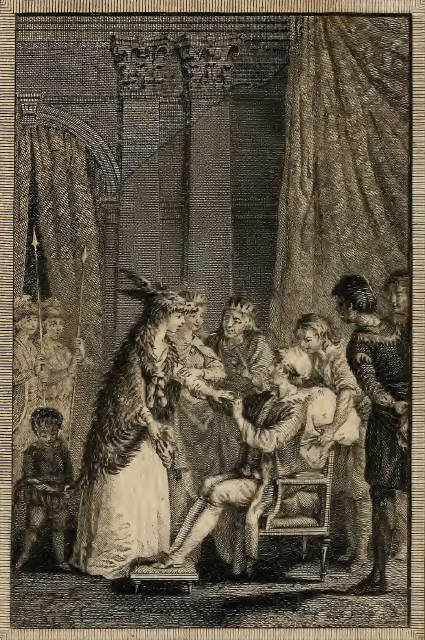
Donkeyskin Illustration by Clement Pierre Marillier
Throughout the tale, she wears her ring always because this is the talisman of her heart, reminding her where she comes from, of her love, family and home. She falls in love with the prince, and he with her, because it is based on something beyond skins; she fell in love with his gentleness towards the people on the farm, and his ability to vow to her despite her “low” status.
And he too loved her for her gentleness – gentleness of hand, symbolizing her gentle touch and kindness of heart. He humbled himself on knees, and opened his heart with vulnerability, desire and integrity; and so she too took off her outer skin to unveil her heart also. It’s a tale of love after all as all tales are, love of self and shared love with another – a love that unfolds along the way, in mysterious yet wild and natural ways.
Spiritual development isn’t for the faint of heart, and requires a lot of courage and self-knowledge gained through work and perseverance; but real love too isn’t for the faint of heart. And for love, real love, it is all worth it, so fearless follow the drumming of your heart, have faith and have trust. And do not settle for anything less than someone who sees you, hears you, and respects you for who you truly are – and loves you entirely and wholly, wholly, wholly.
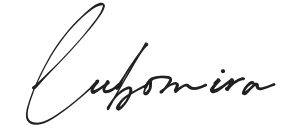
For more of my writings, browse through my Art of Love.
If you wish to support me and my work, you may do so by sharing it or donate here. For personal readings with me, you may visit my Offerings.
Your support means so much to me! Thank you wholeheartedly!
Cover photography by Maxime Simoncelli.
All rights reserved by the artists.

